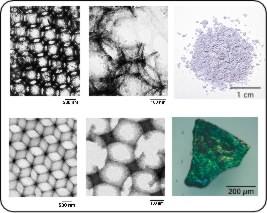As light is used increasingly in the flow and processing of information, it is necessary to develop new devices that can control photons. An emerging field addressing this issue involves photonic crystals, materials with a periodic variation in refractive index. Photonic crystals that exhibit photonic band gaps (PBG, a range of wavelengths that cannot be transmitted through the material) have foreseeable applications as waveguides, microcavity lasers, or inhibitors of light emission. Since the seminal theoretical work by John and Yablonovitch on photonic crystals, much research effort has been dedicated to fabricating photonic crystal structures. Lithographic and reactive ion-etching techniques have been used to prepare two-dimensional photonic crystals, but the construction of three- dimensional structures has been more difficult and expensive. alternative, chemical route involves the use of colloidal crystal templating to form three-dimensionally ordered macroporous (3DOM) dielectric structures. Monodisperse spheres (polystyrene, poly(methylmethacrylate), silica) are close-packed iinto ordered arrays and infiltrated with a fluid which is solidified. After removal of the template, a solid skeleton is obtained around an ordered array of voids where the original spheres were located. We have pioneered methods of preparing 3DOM structures with a wide range of compositions (metals, alloys, oxides, hybrid materials). 3DOM structures meet several of the requirements for PBG materials: they can be prepared in desirable structures (face-centered cubic, fcc) with periodicities on a length scale overlapping with the wavelength of light, they have low volume fractions of solid material, and a wide range of compositions allows modification of the refractive index.
3DOM materials display a number of interesting optical properties with less stringent structural requirements. We have been able to prepare brightly colored 3DOM zirconia and titania samples in gram quantity, covering the whole visible spectral range. These materials have potential applications as non-toxic, chemically stable pigments. Furthermore their colors (stop-band positions and intensities) can be modified reversibly by filling the pores with fluids of varying refractive index. The stop band position varies nearly linearly with refractive index of the penetrating fluid, and can be altered by adjusting the pore spacing, and the thickness, density, and composition of the walls—all parameters that we can control through chemistry. We have also altered photoemission properties of 3DOM silica materials through structural modifications.
A critical factor in optimizing optical properties of these materials is the ability to control the fine structure of the walls. The walls are composed of fused nanocrystals whose sizes influence the optical response of the material. For example, well-ordered 3DOM zirconia with 30 nm wall grains appears white, while a material with 2 nm grains exhibits brilliant colors. One aspect of our research involves optimizing nanograin sizes and phases by controlling precursor chemistry, template–precursor interfacial interactions, and processing conditions.


